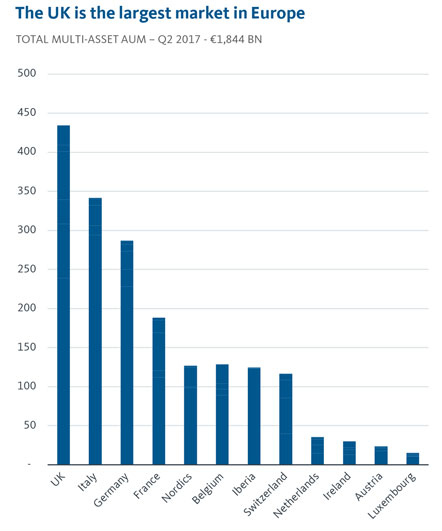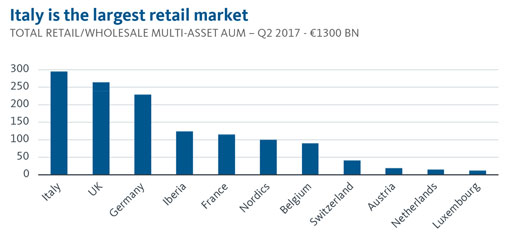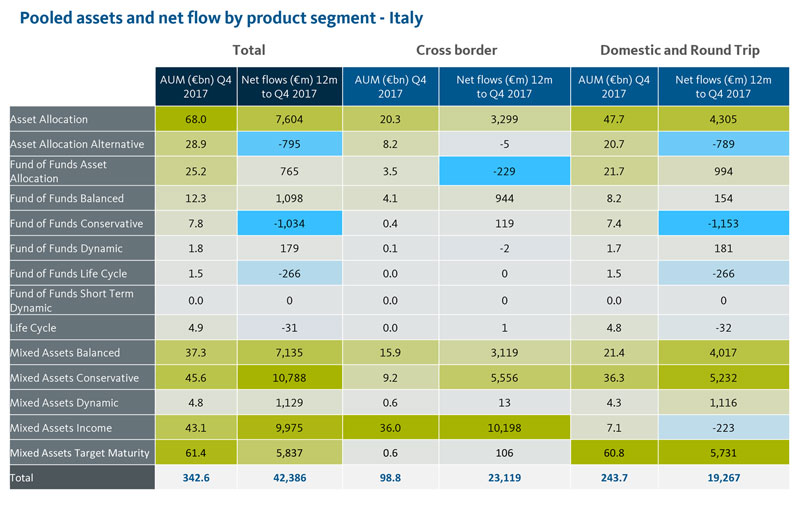MiFID II Continues to Drive Multi-Asset Fund Growth

The market for multi-asset funds currently represents $1.8 trillion in Assets Under Management (AUM). Almost 10,000 funds and thousands of segregated mandates continue to be driven by retail investors in countries such as Italy and Germany, looking to diversify risk and mitigate volatility. Today, new rules, which are part of MiFID II, around transparency and product appropriateness will continue to drive asset growth at a time of considerable change in European fund management.
As the advisory industry grapples with due diligence and compliance headaches to prove proper client asset allocation, multi-asset funds are proving a worthy ally – helping to automate the diversification of risk across global equity, bond and cash markets. It’s a strategy that appears to be working. In the 12 months up to end of Q2 2017, the retail/wholesale flows were €126bn versus a total of only €16bn in institutional.

A look across Europe
Italy, the heartland of multi-asset, remains the fastest growing market by absolute net flow, expanding by approximately €35bn in the 12 months to Q2, 2017. This significantly outstrips Germany as Europe’s second largest retail market. Both countries have retail investors that are income and outcome orientated, with minimal appetite for risk.
However, the real story here for Germany is its strength in institutional net flow growth. Now the fastest growing market in Europe, the country has added significantly to AUM in recent months. Although, one €5bn transaction does influence the picture here.
Yet these developments have not uprooted institutional hubs for multi-asset investment, namely the UK and Switzerland. This is despite growing criticism among consultants who are increasingly questioning the merits of these products. Here, large pension funds continue to invest in flexible asset allocation or balanced funds popular with UK and Swiss investors alike.

Who’s leading the charge?
Intesa SanPaolo Group is the largest multi-asset manager, with 356 funds and €84.2bn AUM; as of Q4 2017 it owned up to 4.18% of the market share. When looking at how the product is built up we see asset allocation alternative, asset allocation and funds of funds made up the highest percentage.
Amundi is the second largest multi-asset manager, with 311 funds. As of Q4 2017 the AUM amounted to €79.4bn with the highest net flows in 12 months to Q4 2017, €9.6bn. The product mix is primarily built up from fund of funds, asset allocation and mixed asset income.
Allianz Global Investors, Standard Aberdeen and BlackRock were also in the top five largest multi-asset managers, with asset allocation alternative, fund of funds and asset allocation building up the majority of their product mix.
Distribution models are evolving
The growth witnessed in the European multi-asset market has mostly been built up from retail investment. For Italy, being the biggest market for retail investment into multi-asset, banks remain the dominant fund distribution channel. However, the Promotori Finanziari (financial advisory networks) is a key distribution channel for international third-party fund providers. In the wider European retail market bank distributors also dominate, though advisory networks in Germany and to a lesser extent Spain are seen as increasingly important targets for independent fund providers.
The UK independent financial advisory market is witnessing a growing trend in outsourcing asset allocation to multi-asset managers and DFMs due to regulatory pressures and an increased cost burden of managing asset allocation in-house. Key distributors are typically favouring passive, risk targeted MA products.
Wider adoption of outcome-oriented solutions and sub-advisory is driving increased usage of third-party MA funds with wealth managers. There is an increased targeting of lower tier affluent clients as opposed to the higher threshold stipulated by higher end private banks. White-labelling and sub-advisory is widely seen as a growth opportunity, driven by MiFID II and increased product complexity.
B2B platforms continue to cut fund buy lists and some, such as Hargreaves Lansdown, have adopted more stringent quant analysis for selecting active managers – especially in relation to performance. While the D2C platforms’ distribution represents around 7-8% of the mutual fund market in the UK (£180-£200 billion), it is expected to grow to 20% in five years despite the high costs involved in establishing a platform. Growth is expected to be slower in mainland Europe.
Identifying the opportunity
The increasing incorporation of ESG into portfolios will be a growing trend in multi-asset fund make up. Looking at institutional investment, in the future we expect portfolios will have to incorporate an ESG aspect in some form into portfolio strategies. Up until now, ESG has been more focused on equity strategies but it is rapidly being integrated into fixed income and alternative products. As such, ESG will be a continuing theme across institutional multi-asset.
Multi-asset income strategies and absolute return are also a growing opportunity, especially in retail. Whilst there has been some concern about the performance of some absolute return products, total return will appeal, particularly in markets like Germany, and is going to continue to resonate with investors.
Retail multi-asset AUM is expected to top €1.3tn by 2020 with the institutional segment representing just €370bn. Equity focused funds will likely outperform those with more exposure to fixed income. However, retail investors especially will want to hedge their bets and adopt a flexible investment approach in a more volatile trading environment.

